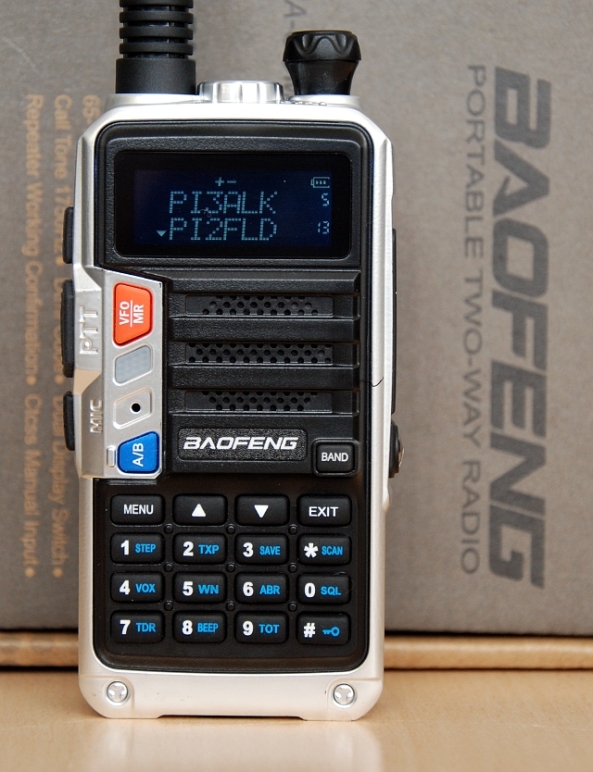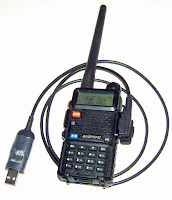Posts Tagged ‘baofeng’
 Finally got rid of the pirated USB chips for the UV-5R and the AP510
Finally got rid of the pirated USB chips for the UV-5R and the AP510
Both the Baofeng UV-5R handheld UHF/VHF radio and the Sainsonic AP510 APRS tracker come with interface cables with pirated chips. These are clones of Prolific USB/serial chips. Since Prolific has taken measures against this, only old drivers will work with them. That means that one has to stop automatic driver updates as explained on the Miklor site for the Baofeng UV-5R. The same is true for the AP510. This is a nuisance.
I got tired of this and got myself some USB/serial modules from Ebay based on the CP2102 chip instead. The cost was US $1.43 a piece so it should be affordable for anyone. I also got some clear heat shrinkable tube.
It wasn’t too hard to follow the instructions on the Miklor site. I ended up replacing the chip in the original Baofeng serial cable. I’m a hardware guy so I think it is a shame not to see the three LEDs for power, rx, and tx so I used my Dremel to make a 12×12 mm cut-out in the original case, and then I closed it by using transparent shrinkable tube. For a picture, see the top of the first image.
If it doesn’t work the first time, exchange rx and tx and see if that works better. According to this site, the boards can be marked just opposite of what you might think.
The Sainsonic AP510 APRS unit has a cable that on first sight just looks like a standard USB cable, but it also contains such a chip. Here I made a completely new cable without any case. It is important that 5 Volts also passes through as this is used for charging. The pinout can be found on the site of DJ7OO (use Google translate if needed). I enclosed the board in shrinkable tube which is transparent enough for the LEDs to shine through as seen in the bottom of the first image. The board with the fake chip is found in the middle.
 So now I have interface cables for both units that don’t require me to stop updates of drivers or any other special precautions and it is much easier to program the devices from any PC.
So now I have interface cables for both units that don’t require me to stop updates of drivers or any other special precautions and it is much easier to program the devices from any PC.
 Finally got rid of the pirated USB chips for the UV-5R and the AP510
Finally got rid of the pirated USB chips for the UV-5R and the AP510
Both the Baofeng UV-5R handheld UHF/VHF radio and the Sainsonic AP510 APRS tracker come with interface cables with pirated chips. These are clones of Prolific USB/serial chips. Since Prolific has taken measures against this, only old drivers will work with them. That means that one has to stop automatic driver updates as explained on the Miklor site for the Baofeng UV-5R. The same is true for the AP510. This is a nuisance.
I got tired of this and got myself some USB/serial modules from Ebay based on the CP2102 chip instead. The cost was US $1.43 a piece so it should be affordable for anyone. I also got some clear heat shrinkable tube.
It wasn’t too hard to follow the instructions on the Miklor site. I ended up replacing the chip in the original Baofeng serial cable. I’m a hardware guy so I think it is a shame not to see the three LEDs for power, rx, and tx so I used my Dremel to make a 12×12 mm cut-out in the original case, and then I closed it by using transparent shrinkable tube. For a picture, see the top of the first image.
If it doesn’t work the first time, exchange the rx and tx connections and see if that works better. According to this site, the boards can be marked just opposite of what you might think.
The Sainsonic AP510 APRS unit has a cable that on first sight just looks like a standard USB cable, but it also contains such a chip. Here I made a completely new cable without any case. It is important that 5 Volts also passes through as this is used for charging. The pinout can be found on the site of DJ7OO (use Google translate if needed). I enclosed the board in shrinkable tube which is transparent enough for the LEDs to shine through as seen in the bottom of the first image. The board with the fake chip is found in the middle.
 So now I have interface cables for both units that don’t require me to stop updates of drivers or any other special precautions and it is much easier to program the devices from any PC.
So now I have interface cables for both units that don’t require me to stop updates of drivers or any other special precautions and it is much easier to program the devices from any PC.
 Review Baofeng FF-12P (UV-5X)
Review Baofeng FF-12P (UV-5X)
Probably because Baofeng is running out of letters (although I didn’t see the Baofeng UV-5Y or Z yet), there’s a new numbers game in order. The FF-12P is essentially a UV-5X and my sample came in…. silver.
 The radio houses the latest chip set and firmware. Pressing various keys confirm this: pressing ‘0’ for a bit more than a second shows the battery voltage, pressing PTT + Band generates 2100 Hz, PTT + A/B generates 1750 Hz, and PTT + VFO/MR generates 1450 Hz.
The radio houses the latest chip set and firmware. Pressing various keys confirm this: pressing ‘0’ for a bit more than a second shows the battery voltage, pressing PTT + Band generates 2100 Hz, PTT + A/B generates 1750 Hz, and PTT + VFO/MR generates 1450 Hz.
The display is of the inverse type, the antenna the short one we all learned to hate, “FF-12P” is printed on both the left and right side of the radio. Batteries / accessories aren’t compatible with the standard UV-5R. While I could find enough suppliers of the FF-12P and UV-5X, not a single one appears to sell spare batteries or any other accessory.
Charger / battery combination
I wasn’t able to charge the battery at first, because the battery and charger don’t match: the two indentations of the battery prevented it from being inserted in the charger. After scraping away enough plastic in the charger I got it to fit.
CHIRP
CHIRP recognized the radio as being a UV-5R and squelch thresholds could be modified without a problem.
Scanning
A clip on YouTube suggested that the UV-5X / FF12P scans faster. This proves to be true: the FF-12P outperforms all other Baofeng radios I own, including the GT-3 Mark II. Scan speed is about 5-6 channels/sec.
Transmitter
Frequency accuracy of the sample: +2 Hz on VHF, -11 Hz on UHF.
Power output VHF: (@ 15 MHz): 4.1 Watts (high), 1.7 Watts (low)
Power output UHF: (@ 435 MHz): 3.6 Watts (high), 1.8 Watts (low)
TX Audio: Bright and loud. Very nice.
Harmonics: the usual peaks on VHF and UHF. Still not very impressive.
Receiver
RX Audio: good.
Front-end: surprisingly good, just like the GT-3 Mark II. Nice.
Sensitivity: -127 dBm (VHF), -125 dBm (UHF). These are good numbers.
Conclusion
The FF-12P aka UV-5X is the typical Baofeng: value for money, but not without its flaws. Harmonic suppression is a mixed bag and the lack of accessories is a potential problem.
The fact that I had to modify the charger to make the battery fit is a dumb factory mistake. The short stock antenna just doesn’t want to die — put a few bucks aside to buy a better one.
The positive side of the radio is the good receiver, good TX audio and faster scan speed. And, if you care about such things, it comes in shiny SILVER!
 Review Baofeng FF-12P (UV-5X)
Review Baofeng FF-12P (UV-5X)
Probably because Baofeng is running out of letters (although I didn’t see the Baofeng UV-5Y or Z yet), there’s a new numbers game in order. The FF-12P is essentially a UV-5X and my sample came in…. silver.
 The radio houses the latest chip set and firmware. Pressing various keys confirm this: pressing ‘0’ for a bit more than a second shows the battery voltage, pressing PTT + Band generates 2100 Hz, PTT + A/B generates 1750 Hz, and PTT + VFO/MR generates 1450 Hz.
The radio houses the latest chip set and firmware. Pressing various keys confirm this: pressing ‘0’ for a bit more than a second shows the battery voltage, pressing PTT + Band generates 2100 Hz, PTT + A/B generates 1750 Hz, and PTT + VFO/MR generates 1450 Hz.
The display is of the inverse type, the antenna the short one we all learned to hate, “FF-12P” is printed on both the left and right side of the radio. Batteries / accessories aren’t compatible with the standard UV-5R. While I could find enough suppliers of the FF-12P and UV-5X, not a single one appears to sell spare batteries or any other accessory.
Charger / battery combination
I wasn’t able to charge the battery at first, because the battery and charger don’t match: the two indentations of the battery prevented it from being inserted in the charger. After scraping away enough plastic in the charger I got it to fit.
CHIRP
CHIRP recognized the radio as being a UV-5R and squelch thresholds could be modified without a problem.
Scanning
A clip on YouTube suggested that the UV-5X / FF12P scans faster. This proves to be true: the FF-12P outperforms all other Baofeng radios I own, including the GT-3 Mark II. Scan speed is about 5-6 channels/sec.
Transmitter
Frequency accuracy of the sample: +2 Hz on VHF, -11 Hz on UHF.
Power output VHF: (@ 145 MHz): 4.1 Watts (high), 1.7 Watts (low)
Power output UHF: (@ 435 MHz): 3.6 Watts (high), 1.8 Watts (low)
TX Audio: Bright and loud. Very nice.
Harmonics: the usual peaks on VHF and UHF. Still not very impressive.
Receiver
RX Audio: good.
Front-end: surprisingly good, just like the GT-3 Mark II. Nice.
Sensitivity: -127 dBm (VHF), -125 dBm (UHF). These are good numbers.
Conclusion
The FF-12P aka UV-5X is the typical Baofeng: value for money, but not without its flaws. Harmonic suppression is a mixed bag and the lack of accessories is a potential problem.
The fact that I had to modify the charger to make the battery fit is a dumb factory mistake. The short stock antenna just doesn’t want to die — put a few bucks aside to buy a better one.
The positive side of the radio is the good receiver, good TX audio and faster scan speed. And, if you care about such things, it comes in shiny SILVER!
 How do they ever make a profit?
How do they ever make a profit?
On the internet you can buy a dual-band handheld with antenna, battery, chargers(2), earpiece and belt clip for just £25.29. At this price I find it unbelievable they can make a profit. I think it is even cheaper if you buy a batch of 3.
.
See http://www.banggood.com/LBaofeng-UV-5RA-Yellow-Dual-Band-Transceiver-Radio-Wakie-Talkie-p-947385.html .
Shipping is just 29p. shipped to the UK by registered air parcel. It is available in a variety of case colours.
 Very low cost 70cm UHF handhelds
Very low cost 70cm UHF handhelds
See http://www.southgatearc.org/news/2014/october/price_of_70cm_handhelds_falls.htm#.VDP48MnTCSo .
This is incredible: a 5W handheld for less than £8.
Looking on eBay, just £6.99 ($11) will buy a 70cms unit with charger from Singapore. Tell me, how can ANYONE make money on these?
Thanks to G1KQH, a link to a review:
http://hamgear.wordpress.com/2012/08/11/review-baofeng-bf-666s-bf-777s-bf-888s-and-look-alikes/
 LHS Episode #127: Dirty Catfish
LHS Episode #127: Dirty Catfish
 In this episode, your intrepid hosts discuss several ham-radio related stories including operators interfering with jail communications, getting lost in strange valleys, and transmitting through a hammock. But that’s only the beginning. Thanks for tuning, and for being a valued listener of our show.
In this episode, your intrepid hosts discuss several ham-radio related stories including operators interfering with jail communications, getting lost in strange valleys, and transmitting through a hammock. But that’s only the beginning. Thanks for tuning, and for being a valued listener of our show.
73 de The LHS Guys















